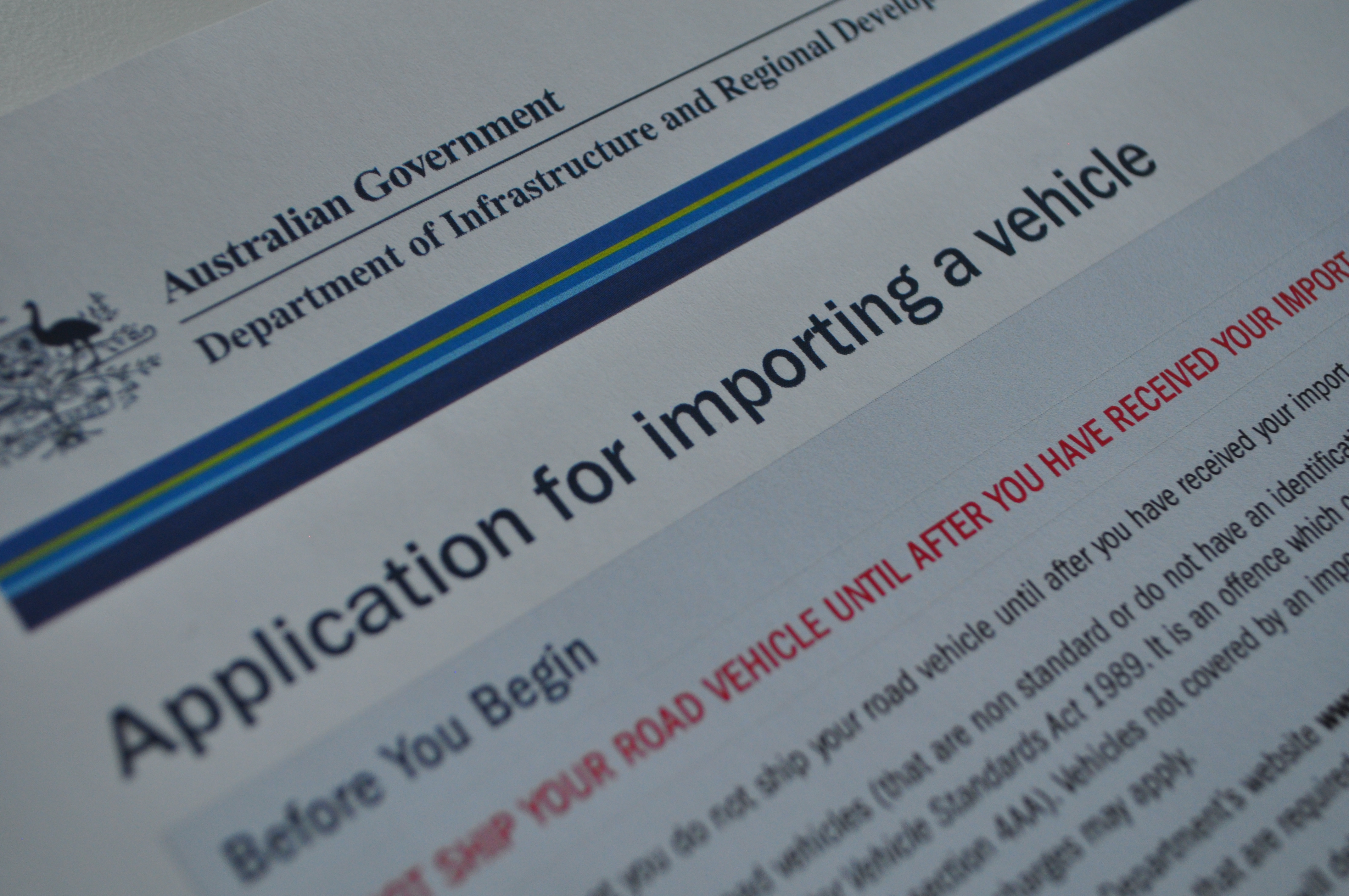If you want to import a vehicle into Australia, be aware that your status and the age and origin of the vehicle will determine if the car can be imported. They also affect the documentation you need to present [1].
What are the regulations during the import process?
- RAW Process
- Modification works
- Vehicle Import Approval
- Import duties and taxes
- Quarantine inspection
- State Department Motor Vehicle Registration
- Personal Import Plate
RAW Process
The Registered Automotive Workshop Scheme (RAWS) allows the importation of used specialist or enthusiast vehicles into Australia. Only a RAW can import a used vehicle into Australia [2].
First, you should find out if your make and model of car is currently approved [3]. If it is not approved a RAW [4] may import it for you. Check if your car is eligible [5].
Before obtaining a Used Import Plate (required for first registration and for use as transport in Australia), the RAW must modify the car to ensure that it meets minimum safety and environmental standards from the Australian Design Rule (ADR) [6].
A typical ADR testing includes [7]:
| ADR 3 | Seat Testing |
| ADR 4/03 | Seat Belt Geometry & Seat Belt Fitting |
| ADR 5/04 | Seat Belt Anchorage Testing |
| ADR 8/01 | Windscreen Transmissivity Test |
| ADR 13/00 | Lighting Installation Tests |
| ADR 14/02 | Field of View Testing |
| ADR 18/02 | Location & Visibility of Indicator Testing |
| ADR 18/02 | Speedometer & Odometer Accuracy Testing |
| ADR 22/00 | Head Restraint Testing |
| ADR 28/01 | Noise Test |
| ADR 29/00 | Side Door Strength Testing |
| ADR 34/01 | Child Restraint Anchorage Testing |
| ADR 35/01 | Brake Tests |
To be eligible for importation through RAWS the vehicle must have been used in transport outside Australia and either been [8]:
- Specialist and Enthusiast Vehicle Scheme (SEVS) eligible. You can apply for eligibility SEVS [9].
- A two or three wheeled L-group category vehicle (motorcycle) that meets the requirements for importation through RAWS.
RAWS arrangements do not apply for cars [10]:
- Manufactured before 1st January 1989
- Imported under the Personal Import Scheme
Modification works
Australia has very strict safety and emissions standards. When vehicles don’t meet the Australian standards they need to go through a modification process. This modification work can sometimes be expensive. However, modification works are not needed if your vehicle was [11]:
- Owned and used in the country of origin for a period of more than 12 months by the importer.
- Originally manufactured or sold in Australia and carries the compliance plate fitted at the time of original manufacture.
- Manufactured before January 1st 1989.
- Newly purchased and manufactured to meet with Australian safety and emission standards.
Vehicle Import Approval (VIA)
- VIA must be obtained before arrival in Australia.
- Applications normally take between 4-6 weeks to be processed and returned.
- You can apply online for the VIA [12].
- When doing the application online an AU $50 fee and documentation are required [13].
In case you ship for a temporary period of time, VIA is not required but you will need a Carnet de Passage [14]. Also, the vehicle can’t stay in Australia longer than the allowed and cannot be sold.
Import duties and taxes
The import tax and duties will be based on the value of the imported vehicle (Customs Value). An approved vehicle value assessor will determine the customs value of your vehicle. Duty and Good and Services Tax (GST) rates are:
| GST | Duty | |
| Cars up to 30 years old | 10% | 5% |
| Cars over 30 years old | 10% | 0% |
| 4×4, off road and commercial cars | 10% | 5% |
Quarantine inspection
On arrival at destination every used vehicle has to go through quarantine inspection on quay [15].
- If the vehicle doesn’t pass inspection: it will be cleaned in a cleaning depot on the wharf and then, re-inspected.
- If the vehicle passes the inspection or is new: you choose to collect your vehicle from a depot or a haulier can deliver it to a specific address.
State Department Motor Vehicle Registration
Your vehicle also must be checked by the State Department Motor Vehicle Registration service who will provide you a Road Worthiness Certificate.
After the fees payment, you will be provided with a yearly registration label. This need to be displayed in your vehicle windscreen together with the Australian number plate assigned to your car.
- Roadworthy Test approximately AU $200.
- Registration fees approximately AU $500 – AU $600.
- Stamp duty fees 3%-6.5% of the car value.
[16]
Personal Import Plate
Once the car is registered, Part 3 of the Personal Import Approval must be forwarded with the fee to the company identified on the Personal Import Approval form. You will be provided with a Personal Import Plate which means that your vehicle is fully approved and registered for use in Australia [17].
Sign up today for all information regarding car import regulations in Australia. AUCO team is also happy to solve any queries you may have!
[2] http://www.raws.com.au/RAWSStory.asp?iss=3
[3] http://rvcs-prodweb.dot.gov.au/sevs/sevsindex.htm
[4] http://raws.infrastructure.gov.au/rawswebpublic/RAWPubSearch.asp
[5] http://raws.infrastructure.gov.au/rawswebpublic/RAWPubSearch.asp
[6] http://rawscompliance.com.au/how-raws-works/
[7] http://www.raws.com.au/Services.asp
[8] http://raws.infrastructure.gov.au/
[9] http://www.infrastructure.gov.au/roads/motor/sevs/pdf/SEVS_application_form_April_2014.pdf
[10] http://raws.infrastructure.gov.au/
[12] https://www.infrastructure.gov.au/vehicles/imports/online_form.aspx
[13] http://www.infrastructure.gov.au/vehicles/imports/obtain.aspx
[14] http://www.infrastructure.gov.au/vehicles/imports/import_options/carnet.aspx
[15] http://www.agriculture.gov.au/biosecurity/import/vehicles-machinery/motor-vehicles
[16] [17] http://www.autoshippers.co.uk/shippingdocuments/Australia_Car_Shipping_Guide.pdf


